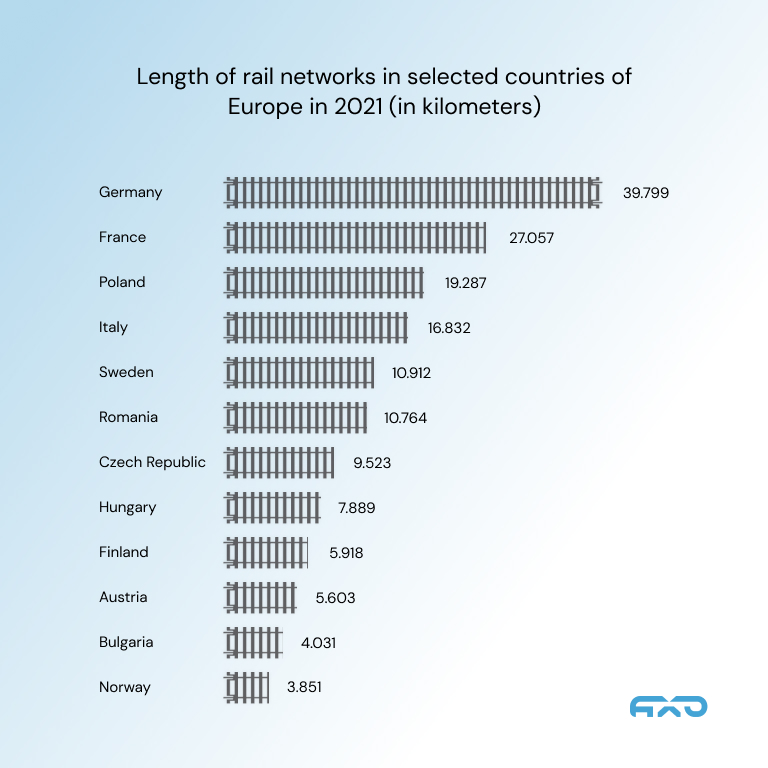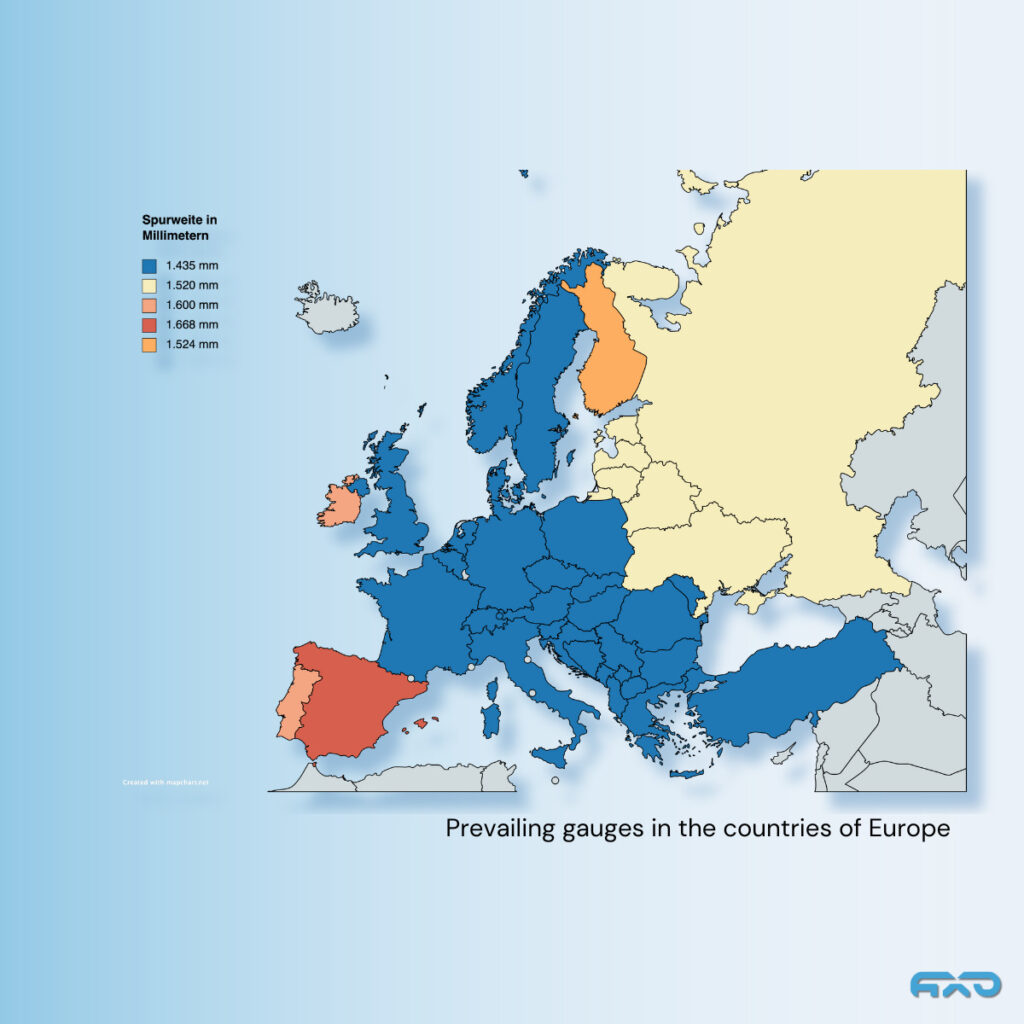From Augsburg to Amsterdam or from Zurich to Zagreb – Europe’s rail network is extensive and connects the whole continent. But, depending on the destination, it might be quite time-consuming to travel Europe by train. In return, though, the journey is quite an experience, as no other means of transport allows passengers to enjoy the landscape flying past the window in such a relaxed way as a train. However, cross-border rail traffic can face challenges due to differing rail systems and technical standards. We show where rail interoperability can sometimes hit a snag, and how the EU wants to harmonize rail travel in Europe.
It’s amazing to see how extensive the European rail network is: it covers around 230,000 kilometers! That’s huge – especially if you compare it to others. For example, the U.S. network is “only” around 290,000 kilometers, even though the ground area of the United States is more than twice as large.
So why not explore Europe by train?
In Germany, this seems to be a trend. The national railway company Deutsche Bahn (DB) announced that booking figures for international long-distance travel have risen significantly. In the first quarter of the year alone, 4.4 million Germans traveled to other European countries by train. That’s 40 percent more than in the previous record year of 2019. In 2022, a total of more than 16 percent of travelers used DB’s long-distance services internationally. In 2019, the figure was still 13 percent.
For the most part, the trip leads to a neighboring country, At the top of the list is France, followed by Austria and Belgium. But of course, these trips can also be extended beyond other national borders. There is certainly no shortage of routes:

To make such long trips, however, travelers should not be under time pressure. Timetables are often not coordinated. Tickets may need to be purchased from national train providers when changing trains. Fortunately, this will change in the coming years when the connection to the OSDM interface (Open Sales and Distribution Model) is completed.
In other words: These issues can be easily resolved with proper planning and preparation. The real challenge comes with technical interoperability, or the compatibility of different rail systems across countries. This remains a significant barrier for seamless travel across borders.
Technical Interoperability Challenges
Different power supply systems
In Europe, there are a variety of different standards for power supply to railroads. They can vary from country to country and even within the same country. For example, power supply systems for high-speed lines may differ from those for conventional lines. Both direct current and alternating current are used for rail operations, and frequencies and voltages also vary by region.

Non-uniform signal and train control systems
Similar to road traffic, trains are also subject to traffic rules, which are defined by signs and signals which dictate the speeds on the lines. To control this, train control systems are used that continuously monitor the permitted speed and can even brake automatically if, for example, a stop signal is crossed. However, due to differences in infrastructure and regulations across different countries and regions, we see about 20 different train control systems in Europe. Germany uses two systems: the point-based train control system (PZB) and the line-based train control system (LZB). Other examples of train control systems include European Train Control System (ETCS), Automatic Train Control (ATC), and Positive Train Control (PTC) used in the United States, among others. Despite these differences, the main goal of all train control systems is to ensure the safety of passengers and crew by preventing collisions and enforcing speed limits.
Compatibility of braking systems
Trains normally consist of different vehicles. They may have different designs and characteristics depending on the transport task and intended use. To ensure a uniform braking function in all vehicles of the train, the vehicles are equipped with a braking system. It is important to note that while most indirect-acting, self-acting air brake systems used in European trains are compatible with each other. But still, there may be some exceptions. Compatibility issues can arise if the brake system components of one vehicle are not properly matched with those of another, or if different types of brake systems are used on the same train.
Retrograde clutch systems
In many countries, the use of automatic couplers in rail freight transport has long been common. While automatic coupling is taken for granted in the USA, Russia and China, Europe still relies mainly on laborious manual work with screw couplers. But this is about to change: with the introduction of the Digital Automatic Coupler (DAC), freight cars and their power, data, and compressed air lines will be automatically connected to each other. The introduction of DAC will undoubtedly streamline and improve cross-border freight traffic, as well as save time and labor costs for manual coupling. Europe now has the opportunity to move from being a latecomer to being a pioneer with this introduction. Especially in cross-border freight traffic, the Digital Automatic Coupler can develop its full potential. The technology will be integrated into rail systems across Europe by 2030.
Different track gauges
As each country has its own standards for rail transport, there are different gauges in Europe. The standard gauge, which measures 1,435 mm (4 feet 8.5 inches), is the most common one. It is used in several countries such as Germany, France, Italy, Spain and Great Britain. On the other hand, the broad gauge or wide gauge measures around 1,520 mm (5 feet) and is commonly used in the Baltic states.
In addition to these gauges, there are also narrow gauges with varying widths that are smaller than the standard gauges and may vary by country and region.

When changing to a country with a different gauge, passengers have two options. They have to change trains or wait for a longer rerouting.
Rail Interoperability in Europe is on Its Way
Europe is growing together – and working towards harmonizing technical standards and specifications for rail transport. In the regulation for the trans-European transport networks (TEN-T), for example, the EU Commission plans to standardize track gauges throughout Europe. This will undoubtedly improve the efficiency and reliability of rail travel across the continent.
Interoperability is one of the future trends in the rail industry. Read about other trends in this article.
At the core of harmonization lies the European Rail Traffic Management System (ERTMS), which consists of three main components. The first component is the European Train Control System (ETCS), followed by the digital train radio communication network known as Global System for Mobile Communication – Railway (GSM-R). With the implementation of TSI ZZS 2022, a third technical component, namely Automatic Train Operation, which enables automated traction operation, will be incorporated into ERTMS.
When is ERTMS scheduled to be implemented?
From December 2025, no new rail line in the TEN-T is to be built or renewed without ERTMS being used. By the end of 2040, ERTMS should be in place on the entire TEN-T rail network.
What is the goal of ERTMS?
The standardization of systems should improve interoperability between national rail systems and facilitate cross-border rail traffic. Trains will thus be able to run at higher speeds and shorter distances between them, increasing track capacity. At the same time, it will reduce the risk of signaling and other human errors that can lead to accidents.
What challenges arise in the implementation of TEN-T?
The example of standardization of track gauges shows: Not all European countries are ready for it. Finland and Estonia reject the idea, and Lithuania also does not want to convert any lines. “Changing the track gauges would be neither economically nor operationally feasible,” says Finnish Transport Minister Timo Harakka. Estonia, on the other hand, feels that it is well enough connected to Europe thanks to the new Rail Baltica. The country, moreover, has just invested a lot of money in the electrification of its lines and in new trains.


